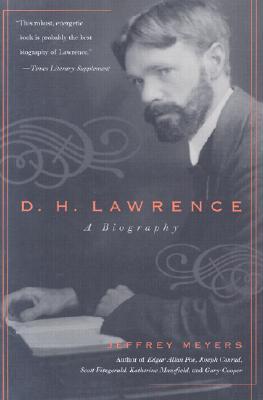The 1950’s were the high point of D.H. Lawrence’s critical reputation. In those days university English professors were keen teachers of Lawrence’s message of “life” and emotional honesty, and he was a popular subject for undergraduate theses. He now appears less frequently on reading lists, and the other day I heard a highschool teacher say that her students found Sons and Lovers funny. Jeffrey Meyers’ objective, dispassionate approach to Lawrence reflects this change of atmosphere, and two things in particular emerge from reading his well-documented, fascinating book: how influential Lawrence has been, and how dated his writing now looks.
These are not irreconcilables. Lawrence, a working-class boy from a mining village out of the mainstream of English life, was really a 19th-century figure, more preacher than artist, more like Ruskin, Kingsley, and Carlyle than his modernist contemporaries. A successful preacher, too: his message can be read on bumperstickers from coast to coast, the creed of the counterculture. Jeffrey Meyers documents its main points: the preference for nature over people, and for the primitive over the civilized; hatred of rational Europe and Christianity; a hankering for “the other,” wherever one might find it; a deep belief in the regenerative powers of sex and the simultaneous orgasm; and an equally deep dislike of America and its belief in liberty and democracy.
On the other hand, though the message lives, the prose it is written in often looks quaint. It has dated like the picture Lawrence enjoyed so much, Maurice Greiffenhagen’s “An Idyll,” and for the same reason: too much fantasy, too little reality. Many of Meyers’ quotations are prose of the kind that Evelyn Waugh’s friend Mary Lygon said “makes one hum,” especially when sex gets mixed up with biblical syntax. Yet even at his kitschiest, Lawrence has been influential. Some characteristic scenes, e.g., sex-in-the-water (admittedly a staple of pornography long before Lawrence) and sex-on-the-beach, are now conventions of erotic fantasy.
Jeffrey Meyers’ matter-of-fact approach tends to emphasize the separation of Lawrence’s content from its form, and questions inevitably arise in the reader’s mind. Take, for instance, the notorious suppression of The Rainbow on grounds of obscenity. As Meyers explains it, the sex in this novel and in Women in Love is not all plain sailing; there is some homosexuality and sodomy. The irony of the legal case, therefore—suspending for a moment any objection one might have in principle to censorship—is that if the publisher had defended The Rainbow, the authorities could have won their case—and the more famous Chatterley case of 1960 as well—but were either too naive or too timid to know it. This is because Lawrence, the prophet of sexual candor, disguised the riskiest scenes in the figurative, high-flown language of the decadent style, as if he were spellbound by the shame and mystery of his own imaginings: “The secret, shameful things are most terribly beautiful” or “How good it was to be really shameful!”
Meyers’ treatment of this element in Lawrence throws an ironical light on the Chatterley trial, at which establishmentarian worthies testified to the book’s moral value. It also reveals a more sinister side to the Lawrenthian gospel. When Lawrence advocates practices that would give a surgeon general nightmares, he is preaching radical or absolute freedom through sex. The character of Ursula in Women in Love is an example, “liberated into perfection” by what Meyers calls, using Lawrence’s words, “her degrading, bestial and shameful experiences with Birkin.” Pursued in real life as opposed to pornographic fantasy, this ritualized perversion is exploitative and dangerous, not to mention offensive; no one who does moral and physical violence to the deepest feelings of modesty will emerge unscathed. Yet Lawrence evidently believed these Byronic acts of defiance to be necessary; he did not describe them in a spirit of cheerful pagan permissiveness.
Jeffrey Meyers’ revelation of Lawrence’s antinomian streak—though he does not use the word—leads one to think that Lawrence’s writing was expressive, not prophetic, and that it expressed his own immoderate, self-centered personality. No one as contradictory as Lawrence can be a real prophet. If, for instance, one is a believer in “life,” as Lawrence claimed to be, then surely one must also believe in purposive evolution, and cannot possibly take an anti-intellectual or anti-rational position. The turn from reason to the primitive, the animal, and instinctual in the name of something called “life,” is all too likely to be a dance of death in disguise.
Yet without following or even sympathizing with Lawrence, one can perhaps understand him. In Lawrence the representative figure and prophet one sees some consequences of bringing people up in brutally ugly surroundings, starved of intellectual and aesthetic nourishment. Lawrence came from a place where the only sources of real pleasure and beauty were sex and nature, both of them continually threatened and degraded by the machine and the machine-minded. In those circumstances the spirit is either dumb or it protests: Lawrence acquired his anger honestly.
Unfortunately, as Meyers shows us, from his unhappy mother he also learnt social and sexual ambition; worse, her contempt for life, backed up by chapel Calvinism, wounded him emotionally, and this must have been the source of his violence. An upbringing like that gives little space for spiritual or imaginative maneuvering: no wonder Lawrence was a wanderer or that he sought initiation into forbidden realms.
Flawed as a writer and as a man, dead at 44, Lawrence nevertheless imposed his savage vision. Between his ailing psyche and a society with much to be ashamed of, there proved to be an essential sympathy, so much so that one could say of him as of Christopher Wren, “If you want a monument, look about you.” In his Lawrenthian 60’s, even his looks were fashionable. Lawrence lived a sad, always significant life, intensely pathetic at the end; Jeffrey Meyers has told it well.
[D.H. Lawrence: A Biography, by Jeffrey Meyers (New York: Alfred A. Knopf) 445 pp., $24.95]

Leave a Reply